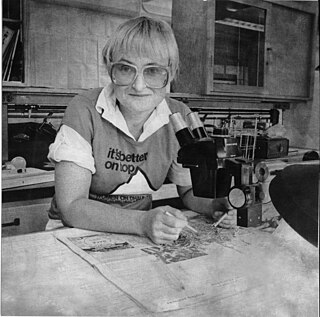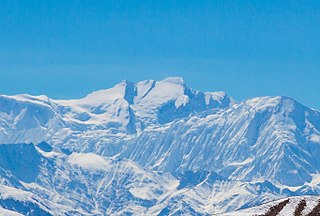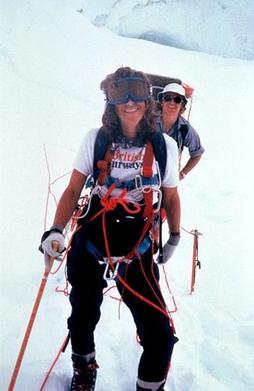
Annapurna is a mountain situated in the Annapurna mountain range of Gandaki Province, north-central Nepal. It is the 10th highest mountain in the world at 8,091 metres (26,545 ft) above sea level and is well known for the difficulty and danger involved in its ascent.

Denali is the highest mountain peak in North America, with a summit elevation of 20,310 feet (6,190 m) above sea level. It is the tallest mountain in the world from base-to-peak on land, measuring 18,000 ft (5,500 m), and Earth's highest mountain north of 43°N. With a topographic prominence of 20,194 feet (6,155 m) and a topographic isolation of 4,621.1 miles (7,436.9 km), Denali is the third most prominent and third-most isolated peak on Earth, after Mount Everest and Aconcagua. Located in the Alaska Range in the interior of the U.S. state of Alaska, Denali is the centerpiece of Denali National Park and Preserve.

Manaslu is the eighth-highest mountain in the world at 8,163 metres (26,781 ft) above sea level. It is in the Mansiri Himal, part of the Nepalese Himalayas, in west-central Nepal. Manaslu means "mountain of the spirit" and the word is derived from the Sanskrit word manasa, meaning "intellect" or "soul". Manaslu was first climbed on May 9, 1956, by Toshio Imanishi and Gyalzen Norbu, members of a Japanese expedition. It is said that, given the many unsuccessful attempts by the British to climb Everest before Nepali Tenzing Norgay and New Zealander Edmund Hillary, "just as the British consider Everest their mountain, Manaslu has always been a Japanese mountain".

Anatoli Nikolaevich Boukreev was a Soviet and Kazakh mountaineer who made ascents of 10 of the 14 eight-thousander peaks—those above 8,000 m (26,247 ft)—without supplemental oxygen. From 1989 through 1997, he made 18 successful ascents of peaks above 8,000 m.

Junko Tabei was a Japanese mountaineer, author, and teacher. She was the first woman to reach the summit of Mount Everest and first woman to ascend the Seven Summits, climbing the highest peak on every continent.

Ginette Harrison was a professional climber of British origin. She also lived in Australia and the United States.

Edurne Pasaban Lizarribar is a Spanish mountaineer. On May 17, 2010, she became the first woman to climb all 14 of the eight-thousanders – and the 21st person to do so. Her first 8,000 peak had been achieved 9 years earlier, on May 23, 2001, when she reached the summit of Mount Everest. She has also completed the seven summits.

A fire retardant is a substance that is used to slow down or stop the spread of fire or reduce its intensity. This is commonly accomplished by chemical reactions that reduce the flammability of fuels or delay their combustion. Fire retardants may also cool the fuel through physical action or endothermic chemical reactions. Fire retardants are available as powder, to be mixed with water, as fire-fighting foams and fire-retardant gels. Fire retardants are also available as coatings or sprays to be applied to an object.
Francys Arsentiev became the first woman from the United States to reach the summit of Mount Everest without the aid of bottled oxygen, on May 22, 1998. She then died during the descent.

Kinga Baranowska is a Polish mountaineer. She made ascents of nine eight-thousanders and is the first Polish woman to have climbed Dhaulagiri, Manaslu and Kangchenjunga. She has also climbed the seven summits.

Oh Eun-sun is a South Korean mountaineer. She was the first Korean woman to climb the Seven Summits. On April 27, 2010, she reached the summit of Annapurna; upon doing so, she claimed to have climbed all fourteen eight-thousanders, which would have made her the first woman to achieve this feat. However, her claim to have ascended Kangchenjunga was disputed by multiple experts. Oh later admitted that she had stopped a few hundred meters before the summit of Kangchenjunga, and so the Korean Alpine Federation ruled that she had not summited. The mountaineering site ExplorersWeb considers Edurne Pasaban as the first woman to have successfully climbed all fourteen peaks.

Musa Ibrahim is a Bangladeshi mountaineer, adventurer, trekker, journalist, and author. He is the first Bangladeshi to reach the summit of Mount Everest. He reached the summit around 5:05 am BST on 23 May 2010 and hoisted the flag of Bangladesh on the apex of the world at around 5:16 am BST. From then, Bangladesh became the 67th Mount Everest conquering country.
Krushnaa Patil is an Indian climber. In 2009, at the age of 19, she became the youngest Indian woman to successfully ascent Mount Everest, earth's highest mountain.

Vera Komarkova was a prominent Czech-American mountaineer and botanist. Credited as a pioneer of women's mountaineering, she was the first woman to summit Annapurna and Cho Oyu.

Susan D. Shaw was an American environmental health scientist, marine toxicologist, explorer, ocean conservationist, and author. A Doctor of Public Health, she was a professor in the Department of Environmental Health Sciences at the School of Public Health at the State University of New York at Albany, and Founder/President of the Shaw Institute, a nonprofit scientific institution with a mission to improve human and ecological health through innovative science and strategic partnerships. Shaw is globally recognized for pioneering high-impact environmental research on ocean pollution, climate change, oil spills, and plastics that has fueled public policy over three decades. In 1983, with landscape photographer Ansel Adams, she published Overexposure, the first book to document the health hazards of photographic chemicals. Shaw is credited as the first scientist to show that brominated flame retardant chemicals used in consumer products have contaminated marine mammals and commercially important fish stocks in the northwest Atlantic Ocean. She became the first scientist to dive into the Gulf of Mexico oil slick following the 2010 BP Deepwater Horizon oil rig explosion to investigate the impacts of chemical dispersants used in response to the spill.

The American Women's Himalayan Expedition was a 1978 expedition to Annapurna which placed the first two women, and first Americans, on its summit. The expedition was led by Arlene Blum and consisted of thirteen women, and six sherpas. On October 15, the first summit team, composed of Vera Komarkova, Irene Beardsley, Mingma Tshering Sherpa and Chewang Ringjin Sherpa summitted Annapurna via the Dutch Route. The second summit team, Alison Chadwick-Onyszkiewicz and Vera Watson, died during the climb.

Alison Chadwick-Onyszkiewicz was a British mountaineer, painter, and lithography lecturer. She made the first ascent of Gasherbrum III, at the time the highest unclimbed mountain in the world. Chadwick-Onyszkiewicz died along with her climbing partner, Vera Watson, during an attempt on Annapurna I Central.
Irene Beardsley is an American mountaineer, and along with Vera Komarkova, the first woman to climb Annapurna, the tenth highest mountain in the world.
Vera Watson was an American computer programmer, mountaineer and rock climber who made the first woman's solo climb of Acongagua, the highest mountain in the Americas. She also made several first ascents in the Kenai Mountains in Alaska. She was a member of the successful first all-women team to climb Annapurna, but was killed along with her partner Alison Chadwick-Onyszkiewicz while preparing to attempt the unclimbed central summit of the mountain.















